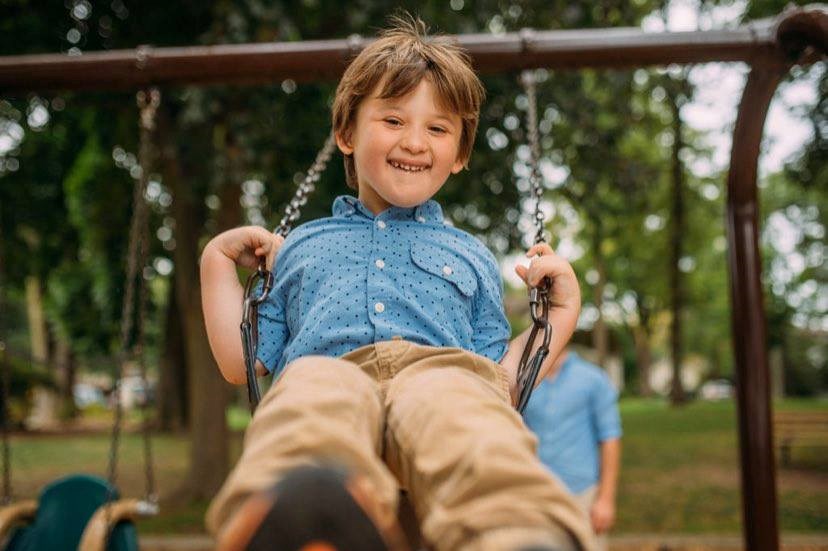Jeremy Chase is like any other five-year-old boy. He likes trains, playing outdoors and hanging out with his older sister. But Chase has KAT6A, a rare genetic disorder affecting the neurological system. Currently there are only 248 people in the world diagnosed with KAT6A.
Jeremy's parents, Kimberly Harvey-Chase and her husband Jeff knew something wasn't quite right at their 20 week ultrasound appointment.
Typically, this is when parents are able to find out the gender of their child, but it is also an important appointment to check-in on baby's development. It was during this appointment they found an anomaly on Jeremy's brain, which is commonly found in cases of down syndrome. They were sent in for another ultrasound at the 30 week mark.
"But they still couldn't figure it out," explained Harvey-Chase.
When Jeremy was born in August 2015, he was tested for down syndrome, but the results came back negative.
"We waited six months, and at six months noticed he wasn't hitting milestones," explained Harvey-Chase. She knew something wasn't right and continued to press doctors for further testing.
Jeremy didn't walk until he was two, and wasn't talking until he was four. He also had a lot of issues with feeding.
"He would choke quite a bit, and had a few instances where he would turn blue," described Harvey-Chase. "It was scary."
When he was around two and half years old, he had a CT scan that showed polyps on his brain.
"We still don't really have that explained," she said.
From there the family was referred to a pediatric geneticist doctor at Sick Kids who was able to refer them for a special Whole Exome Sequencing test. The test takes the blood of the patient and parents to map out their chromosomes to try and find abnormalities. At the time, the test could only be conducted at the request of a specialist, and was not covered by OHIP. Now, the test is available to all pediatricians, and is covered. Harvey-Chase said this test was key in getting the diagnosis for Jeremy.
"The awareness really helps," noted Harvey-Chase about the test and its benefits. "Most people don't know about this test, so they (patients) go undiagnosed."
It took a year for the results to come back, and when they did, they finally got the answers they were looking for. The test results showed an abnormality with the gene, KAT6A. It is a rare genetic condition that results from a mutation in the gene.
People with KAT6A are often developmentally delayed, have difficulty feeding or swallowing, experience seizures, behaviour issues, heart defects, low muscle tone and possess prominent facial features.
In Jeremy's case, he has experienced developmental delays, but with the help and support of teachers at Fieldcrest Elementary School and the Early Years Centre in Bradford, Harvey-Chase says he has made incredible progress.
The condition has weakened Jeremy's immune system. Whenever he gets a common cold of flu, it takes him five times as long to recover, his mother said, and if they are bad enough, can sometimes result in seizures.
She remembers getting a call from her son's school last year because Jeremy was having a seizure. She rushed to the school in a panic, where she saw an ambulance had been called to aid her unresponsive son.
"Seeing him there on the ground, he looked dead, he was so pale, I went to pick him up and he was floppy," she described.
"I still have nightmares about it," she shared.
Jeremy also has low muscle tone which causes him to fall a lot. She said his skull is permanently shaped like a goose egg from all the falling.
"He can be running along and trip and fall and smash his head, which he does frequently," she explained.
Jeremy works with three different doctors to help with his development on things like behaviour and muscle tone. Harvey-Chase said Jeremy is doing well compared to some of the other children his age with the condition.
"He might plateau and not get past that point for the rest of his life, he could excel and live a fairly normal life, we don't really know, we just kind of go with where we are at right now."
But she said, the family takes everything one day at a time, and are hopeful with the ongoing research and studies about the syndrome.
"You can really get inside your own head if you try to overthink it too much," she explained.
"We are lucky living in Canada, because our medical system is really good and we have a lot of money for case studies compared to other countries," said Harvey-Chase.
Jeremy's case is currently being studied by two doctors in Quebec, where they are trying to learn more about how the syndrome and its links to autism.
Rare Disease day was on Feb. 29, and Harvey-Chase wanted to do something special to raise money and awareness about KAT6A and other rare diseases. She hosted one of her many gift shows in Innisfil last weekend, where local vendors are set up to showcase and sell their products and services. Part of the money raised from the event went toward the KAT6A foundation to help with research and finding treatment for children living with the syndrome.
To learn more, check out the KAT6A Foundation website here.



